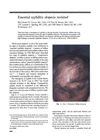TLDR Syphilis can cause hair loss that looks like other conditions, but it improves with treatment.
The document from 1995 discussed two cases of patients with syphilis who exhibited essential syphilitic alopecia as the initial symptom of the infection. A 55-year-old woman experienced rapid scalp hair loss, and a 33-year-old man had diffuse scalp alopecia along with loss of axillary and pubic hair. Both had normal thyroid function, negative HIV tests, but positive tests for syphilis. Scalp biopsies revealed a lymphocytic infiltrate and fewer terminal anagen hairs, resembling alopecia areata. Following syphilis treatment, both patients had significant hair regrowth. The study highlighted the importance of considering syphilis in the differential diagnosis for unexplained hair loss, as its presentation can be similar to that of alopecia areata.
2 citations
,
July 1993 in “JAMA” Hair loss can be a sign of syphilis, and self-diagnosing based on ads can be risky.
 309 citations
,
May 1993 in “Journal of The American Academy of Dermatology”
309 citations
,
May 1993 in “Journal of The American Academy of Dermatology” Horizontal scalp biopsy sections effectively diagnose and predict MPAA, with follicular density and inflammation impacting hair regrowth.
 12 citations
,
October 1976 in “The BMJ”
12 citations
,
October 1976 in “The BMJ” Syphilis can cause hair loss and treating the infection can reverse it.
 29 citations
,
January 2017 in “Skin appendage disorders”
29 citations
,
January 2017 in “Skin appendage disorders” Hair loss due to syphilis can be identified using trichoscopy and is treatable with antibiotics.
 45 citations
,
January 2015 in “Dermatology”
45 citations
,
January 2015 in “Dermatology” Hair loss in secondary syphilis is more common than thought and can be reversed with antibiotics.
 3 citations
,
January 2015 in “Dermatology Online Journal”
3 citations
,
January 2015 in “Dermatology Online Journal” Hair loss can be a symptom of syphilis.
 2 citations
,
December 2012 in “Acta Facultatis Medicae Naissensis”
2 citations
,
December 2012 in “Acta Facultatis Medicae Naissensis” A man with HIV had hair loss due to syphilis, which improved after penicillin treatment.
 53 citations
,
May 1995 in “Journal of The American Academy of Dermatology”
53 citations
,
May 1995 in “Journal of The American Academy of Dermatology” Syphilis can cause hair loss that looks like other conditions, but it improves with treatment.







